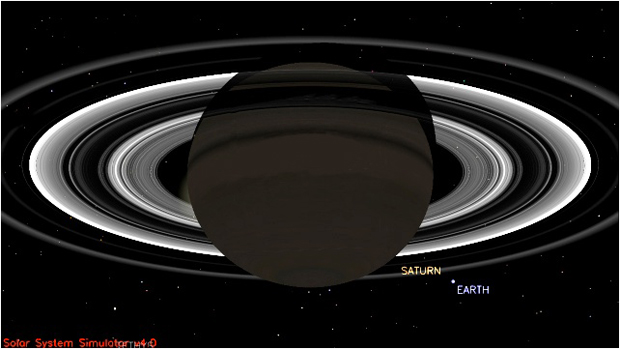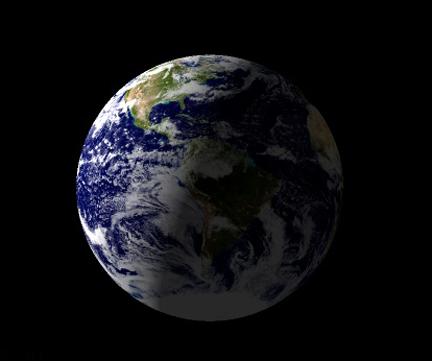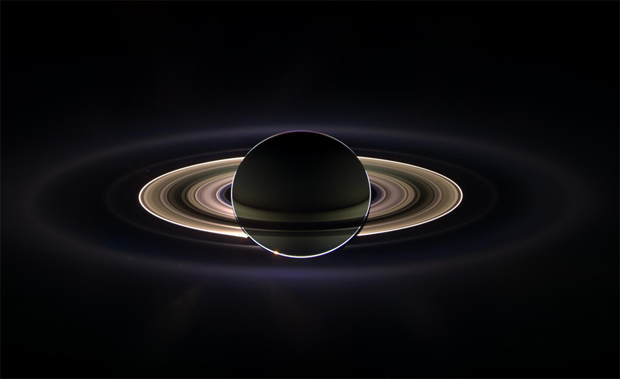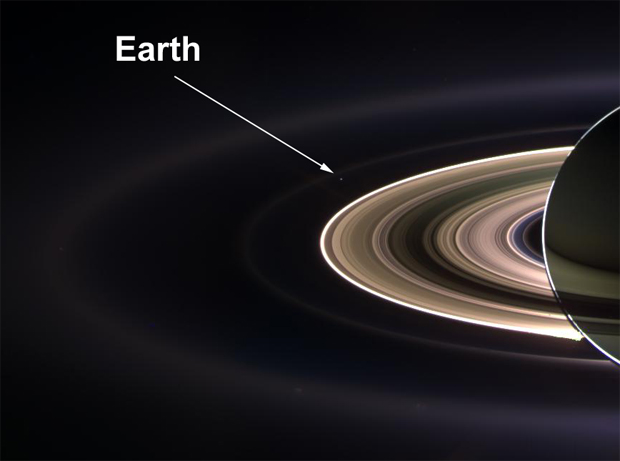Cassini poised to take photo of 'pale blue dot'
By WILLIAM HARWOOD
CBS News
NASA's Cassini spacecraft is poised to snap a dramatic portrait of Earth Friday, capturing a mosaic showing humanity's home in space as a pinprick of light just to one side of Saturn's spectacular rings.
Flying in Saturn's shadow as it loops behind the ringed world, Cassini's cameras will take a series of photos that will be assembled into a mosaic spanning the width of the gigantic ring system and, in the process, capturing distant Earth and its moon some 898 million miles away.
A similar mosaic was assembled in 2006, but the picture was set up for research and did not show the planet and its rings in natural color. This time around, Cassini will capture a view intended from the start for public consumption, one that will show Saturn and Earth as they would appear to an astronaut looking on from Saturn's far side.
At Saturn's enormous distance, the crescent Earth, with the eastern United States illuminated by the sun, will span a single pixel and will appear as a pinpoint of light in the depths of space. The view will be similar to the 2006 image and reminiscent of a shot by the Voyager 1 probe in 1990 from the edge of the solar system.
The Voyager photo was taken at the request of Carl Sagan, who marveled at the "pale blue dot" that was Earth.
Carolyn Porco, leader of Cassini's imaging team at the Space Science Institute in Boulder, Colo., worked with Sagan on the Voyager image and hopes Friday's picture will spark a similar moment of wonder for a much broader segment of the population.
She wants people to step outside and wave at Cassini and to "think about where we are, think about life on planet Earth, how incredibly marvelous it is, think about your own existence, just have a moment of cosmic self awareness."
"I just thought it would be a fantastic moment, a fantastic opportunity, if we could do it again, do it right, make sure the pictures are the correct camera settings, correct filters, all that stuff, do it right and let everybody know in advance so this could become a kind of interplanetary salute between robot and maker."
Along with the globe-spanning mosaic, Cassini also will zoom in on Earth with it's narrow-angle camera. While the spacecraft is simply too far away to capture any detail -- "we're still going to be a pale blue dot," Porco said -- the image should show both the planet and its moon, separated by about 20 pixels.
"The moon, you know, is very much fainter than the Earth so probably we'll have to boost its brightness," Porco said. "But we should, in the narrow angle camera, be able to see both.
"I'm really hoping it's kind of a knock-your-socks-off picture with the diffuse rings in it, Saturn and so on," she said.
Cassini will snap its pictures during a 15-minute period starting at 5:27 p.m. EDT (GMT-4). Friday. The narrow-angle view of Earth and moon is expected to be released within days of the photo session, but Porco said the full mosaic will take six weeks or so to downlink, process and assemble.
Cassini, managed by the Jet Propulsion Laboratory in Pasadena, Calif., braked into orbit around Saturn on July 1, 2004. It completed its original four-year mission in 2008 and a two-year extension in 2010. It currently is flying through a second mission extension and scientists hope to continue collecting data through 2017.
During an ever-changing series of orbits around Saturn, Cassini has chalked up a near flawless performance, dropping off a European Space Agency probe that landed on the surface of the moon Titan and studying the enigmatic planet and its rings in exhaustive detail with state-of-the-art cameras and instruments.
The 2006 picture of Saturn, one of the spacecraft's most popular images, was taken while Cassini was behind the planet as part of a science campaign and the camera settings were adjusted accordingly. While Earth is visible in the picture, Saturn appears in hues that do not mirror what the eye would see.
"It was not taken with the idea of making it a picture that would be good for public consumption," Porco said. "That was basically just because we were so busy when we first got into orbit, for those first two or three or four years. ... The quality of the image is just not very good.
"More than anything else, I really felt it was a wasted opportunity. If people had known in advance their picture was going to be taken, it would have been a tremendous opportunity for people to be high fiving all over the planet and for announcing to the world, you know, look how far we have come in the exploration of our solar system, we have a robot in orbit around Saturn now that is going to take our picture."
Porco never gave up hopes for a second opportunity. Three years ago, she and her staff began studying Cassini's planned trajectory to look for potential photo opportunities, occasions when the spacecraft would be in eclipse behind Saturn and out of the glare of direct sunlight.
As it turned out, July 19 was a good choice, one that did not interfere with normal science operations, and NASA began publicizing the encounter last month, launching a "Wave at Saturn" campaign on its web site (http://saturn.jpl.nasa.gov/news/waveatsaturn/).
"Maybe I'm too starry eyed about all this, but I know this -- when I went around giving talks about Cassini and I end my talk on that September 2006 picture, it's a picture that draws gasps from people," Porco said.
"Regardless of how cynical people are, they look at that and they see Saturn and its rings in a way they've never seen them before, and then they see Earth in the distance. It just gets people. So I was just trying to tap into that, that powerful recognition that moves people, only do it this time in advance."
A passionate advocate of space exploration, Porco set up two web competitions on her Diamond Sky Productions site (http://diamondskyproductions.com/recent/), inviting the public to submit music and photos that capture the moment of the cosmic encounter. A second website, called "The Day the Earth Smiled," provides additional details (http://thedaytheearthsmiled.com/info.php).
She plans to digitize the winning entries and beam them into deep space through a radio telescope as "kind of a long-distance call to our fellow galactic citizens."
The message follows earlier one-way calls to the cosmos, starting with a message developed by astrophysicist Frank Drake and Sagan that was transmitted toward a globular star cluster in 1974 as a demonstration of the capability.
NASA's Pioneer and Voyage probes, all four now departing the solar system, were equipped with messages intended for any aliens who might encounter them in the remote future. Porco began her career with the Voyager project and worked with Sagan to pull off the 1990 Voyager 1 portrait.
"What I'm intending to do with this is make it a serious message a la the previous Drake and Sagan efforts, instruct the recipients of this message how to even read it, and encode important information about us, our planet and so on," Porco said of her "Message to the Milky Way."
One contest, called Earth Beheld, asks the public to "contribute one image that best represents planet Earth and could be understandable to an extraterrestrial recipient.
The other contest -- A Musical Celebration -- asks for compositions capturing the "spirit and significance of The Day the Earth Smiled."
"I hope, at the appropriate time, regardless where or on which side of the planet you are, that you stop what you're doing, go outside, gather together with friends and family, contemplate the utter isolation of our world in the never-ending blackness of space," she wrote on her web site.
"And then, by all means, rejoice! Hoot and holler, twist and shout, raise a glass, make a toast, dance beneath the diamond sky with one hand waving free, or celebrate in silence. Whatever it takes. But be sure to smile, knowing that others around the world are smiling too, in the sheer joy of simply being alive on a pale blue dot."
CBS News
NASA's Cassini spacecraft is poised to snap a dramatic portrait of Earth Friday, capturing a mosaic showing humanity's home in space as a pinprick of light just to one side of Saturn's spectacular rings.
Flying in Saturn's shadow as it loops behind the ringed world, Cassini's cameras will take a series of photos that will be assembled into a mosaic spanning the width of the gigantic ring system and, in the process, capturing distant Earth and its moon some 898 million miles away.
 |
| In this computer simulation, Earth can be seen where it will appear in a photo mosaic that will be shot by NASA's Cassini spacecraft as it flies behind Saturn on Friday. Earth, some 898 million miles away, will cover a single pixel in the photo. (Credit: NASA) |
A similar mosaic was assembled in 2006, but the picture was set up for research and did not show the planet and its rings in natural color. This time around, Cassini will capture a view intended from the start for public consumption, one that will show Saturn and Earth as they would appear to an astronaut looking on from Saturn's far side.
At Saturn's enormous distance, the crescent Earth, with the eastern United States illuminated by the sun, will span a single pixel and will appear as a pinpoint of light in the depths of space. The view will be similar to the 2006 image and reminiscent of a shot by the Voyager 1 probe in 1990 from the edge of the solar system.
The Voyager photo was taken at the request of Carl Sagan, who marveled at the "pale blue dot" that was Earth.
Carolyn Porco, leader of Cassini's imaging team at the Space Science Institute in Boulder, Colo., worked with Sagan on the Voyager image and hopes Friday's picture will spark a similar moment of wonder for a much broader segment of the population.
 |
| The eastern United States will be facing Saturn Friday afternoon with the Cassini spacecraft snaps a picture from the far side of Saturn. (Credit: NASA) |
"I just thought it would be a fantastic moment, a fantastic opportunity, if we could do it again, do it right, make sure the pictures are the correct camera settings, correct filters, all that stuff, do it right and let everybody know in advance so this could become a kind of interplanetary salute between robot and maker."
Along with the globe-spanning mosaic, Cassini also will zoom in on Earth with it's narrow-angle camera. While the spacecraft is simply too far away to capture any detail -- "we're still going to be a pale blue dot," Porco said -- the image should show both the planet and its moon, separated by about 20 pixels.
"The moon, you know, is very much fainter than the Earth so probably we'll have to boost its brightness," Porco said. "But we should, in the narrow angle camera, be able to see both.
"I'm really hoping it's kind of a knock-your-socks-off picture with the diffuse rings in it, Saturn and so on," she said.
Cassini will snap its pictures during a 15-minute period starting at 5:27 p.m. EDT (GMT-4). Friday. The narrow-angle view of Earth and moon is expected to be released within days of the photo session, but Porco said the full mosaic will take six weeks or so to downlink, process and assemble.
Cassini, managed by the Jet Propulsion Laboratory in Pasadena, Calif., braked into orbit around Saturn on July 1, 2004. It completed its original four-year mission in 2008 and a two-year extension in 2010. It currently is flying through a second mission extension and scientists hope to continue collecting data through 2017.
During an ever-changing series of orbits around Saturn, Cassini has chalked up a near flawless performance, dropping off a European Space Agency probe that landed on the surface of the moon Titan and studying the enigmatic planet and its rings in exhaustive detail with state-of-the-art cameras and instruments.
 |
| This 2006 Cassini image showing Saturn from behind the planet is one of the most popular pictures ever snapped by the robotic spacecraft. The picture was intended for research purposes but Friday's shot of Earth and Saturn will be optimized to show the scene in natural color. (Credit: NASA) |
The 2006 picture of Saturn, one of the spacecraft's most popular images, was taken while Cassini was behind the planet as part of a science campaign and the camera settings were adjusted accordingly. While Earth is visible in the picture, Saturn appears in hues that do not mirror what the eye would see.
"It was not taken with the idea of making it a picture that would be good for public consumption," Porco said. "That was basically just because we were so busy when we first got into orbit, for those first two or three or four years. ... The quality of the image is just not very good.
"More than anything else, I really felt it was a wasted opportunity. If people had known in advance their picture was going to be taken, it would have been a tremendous opportunity for people to be high fiving all over the planet and for announcing to the world, you know, look how far we have come in the exploration of our solar system, we have a robot in orbit around Saturn now that is going to take our picture."
Porco never gave up hopes for a second opportunity. Three years ago, she and her staff began studying Cassini's planned trajectory to look for potential photo opportunities, occasions when the spacecraft would be in eclipse behind Saturn and out of the glare of direct sunlight.
As it turned out, July 19 was a good choice, one that did not interfere with normal science operations, and NASA began publicizing the encounter last month, launching a "Wave at Saturn" campaign on its web site (http://saturn.jpl.nasa.gov/news/waveatsaturn/).
"Maybe I'm too starry eyed about all this, but I know this -- when I went around giving talks about Cassini and I end my talk on that September 2006 picture, it's a picture that draws gasps from people," Porco said.
"Regardless of how cynical people are, they look at that and they see Saturn and its rings in a way they've never seen them before, and then they see Earth in the distance. It just gets people. So I was just trying to tap into that, that powerful recognition that moves people, only do it this time in advance."
 |
| A closeup of a segment of the 2006 picture of Saturn showing Earth to one side of the rings. (Credit: NASA) |
A passionate advocate of space exploration, Porco set up two web competitions on her Diamond Sky Productions site (http://diamondskyproductions.com/recent/), inviting the public to submit music and photos that capture the moment of the cosmic encounter. A second website, called "The Day the Earth Smiled," provides additional details (http://thedaytheearthsmiled.com/info.php).
She plans to digitize the winning entries and beam them into deep space through a radio telescope as "kind of a long-distance call to our fellow galactic citizens."
The message follows earlier one-way calls to the cosmos, starting with a message developed by astrophysicist Frank Drake and Sagan that was transmitted toward a globular star cluster in 1974 as a demonstration of the capability.
NASA's Pioneer and Voyage probes, all four now departing the solar system, were equipped with messages intended for any aliens who might encounter them in the remote future. Porco began her career with the Voyager project and worked with Sagan to pull off the 1990 Voyager 1 portrait.
"What I'm intending to do with this is make it a serious message a la the previous Drake and Sagan efforts, instruct the recipients of this message how to even read it, and encode important information about us, our planet and so on," Porco said of her "Message to the Milky Way."
One contest, called Earth Beheld, asks the public to "contribute one image that best represents planet Earth and could be understandable to an extraterrestrial recipient.
The other contest -- A Musical Celebration -- asks for compositions capturing the "spirit and significance of The Day the Earth Smiled."
"I hope, at the appropriate time, regardless where or on which side of the planet you are, that you stop what you're doing, go outside, gather together with friends and family, contemplate the utter isolation of our world in the never-ending blackness of space," she wrote on her web site.
"And then, by all means, rejoice! Hoot and holler, twist and shout, raise a glass, make a toast, dance beneath the diamond sky with one hand waving free, or celebrate in silence. Whatever it takes. But be sure to smile, knowing that others around the world are smiling too, in the sheer joy of simply being alive on a pale blue dot."